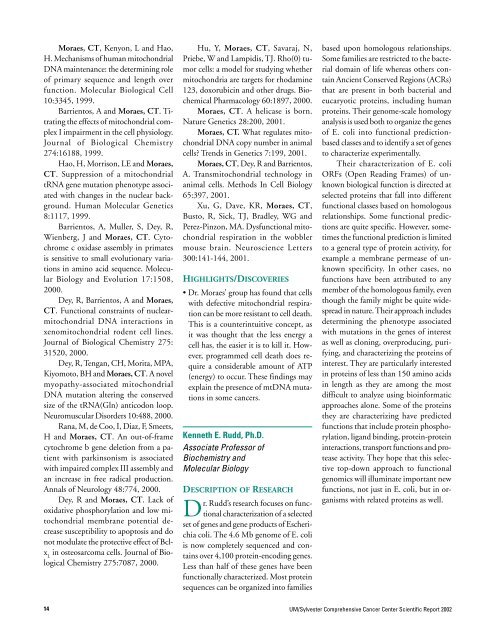tumor cell biology program - Sylvester Comprehensive Cancer Center
tumor cell biology program - Sylvester Comprehensive Cancer Center
tumor cell biology program - Sylvester Comprehensive Cancer Center
You also want an ePaper? Increase the reach of your titles
YUMPU automatically turns print PDFs into web optimized ePapers that Google loves.
Moraes, CT, Kenyon, L and Hao,<br />
H. Mechanisms of human mitochondrial<br />
DNA maintenance: the determining role<br />
of primary sequence and length over<br />
function. Molecular Biological Cell<br />
10:3345, 1999.<br />
Barrientos, A and Moraes, CT. Titrating<br />
the effects of mitochondrial complex<br />
I impairment in the <strong>cell</strong> physiology.<br />
Journal of Biological Chemistry<br />
274:16188, 1999.<br />
Hao, H, Morrison, LE and Moraes,<br />
CT. Suppression of a mitochondrial<br />
tRNA gene mutation phenotype associated<br />
with changes in the nuclear background.<br />
Human Molecular Genetics<br />
8:1117, 1999.<br />
Barrientos, A, Muller, S, Dey, R,<br />
Wienberg, J and Moraes, CT. Cytochrome<br />
c oxidase assembly in primates<br />
is sensitive to small evolutionary variations<br />
in amino acid sequence. Molecular<br />
Biology and Evolution 17:1508,<br />
2000.<br />
Dey, R, Barrientos, A and Moraes,<br />
CT. Functional constraints of nuclearmitochondrial<br />
DNA interactions in<br />
xenomitochondrial rodent <strong>cell</strong> lines.<br />
Journal of Biological Chemistry 275:<br />
31520, 2000.<br />
Dey, R, Tengan, CH, Morita, MPA,<br />
Kiyomoto, BH and Moraes, CT. A novel<br />
myopathy-associated mitochondrial<br />
DNA mutation altering the conserved<br />
size of the tRNA(Gln) anticodon loop.<br />
Neuromuscular Disorders 10:488, 2000.<br />
Rana, M, de Coo, I, Diaz, F, Smeets,<br />
H and Moraes, CT. An out-of-frame<br />
cytochrome b gene deletion from a patient<br />
with parkinsonism is associated<br />
with impaired complex III assembly and<br />
an increase in free radical production.<br />
Annals of Neurology 48:774, 2000.<br />
Dey, R and Moraes, CT. Lack of<br />
oxidative phosphorylation and low mitochondrial<br />
membrane potential decrease<br />
susceptibility to apoptosis and do<br />
not modulate the protective effect of Bclx<br />
L<br />
in osteosarcoma <strong>cell</strong>s. Journal of Biological<br />
Chemistry 275:7087, 2000.<br />
Hu, Y, Moraes, CT, Savaraj, N,<br />
Priebe, W and Lampidis, TJ. Rho(0) <strong>tumor</strong><br />
<strong>cell</strong>s: a model for studying whether<br />
mitochondria are targets for rhodamine<br />
123, doxorubicin and other drugs. Biochemical<br />
Pharmacology 60:1897, 2000.<br />
Moraes, CT. A helicase is born.<br />
Nature Genetics 28:200, 2001.<br />
Moraes, CT. What regulates mitochondrial<br />
DNA copy number in animal<br />
<strong>cell</strong>s? Trends in Genetics 7:199, 2001.<br />
Moraes, CT, Dey, R and Barrientos,<br />
A. Transmitochondrial technology in<br />
animal <strong>cell</strong>s. Methods In Cell Biology<br />
65:397, 2001.<br />
Xu, G, Dave, KR, Moraes, CT,<br />
Busto, R, Sick, TJ, Bradley, WG and<br />
Perez-Pinzon, MA. Dysfunctional mitochondrial<br />
respiration in the wobbler<br />
mouse brain. Neuroscience Letters<br />
300:141-144, 2001.<br />
HIGHLIGHTS/DISCOVERIES<br />
• Dr. Moraes’ group has found that <strong>cell</strong>s<br />
with defective mitochondrial respiration<br />
can be more resistant to <strong>cell</strong> death.<br />
This is a counterintuitive concept, as<br />
it was thought that the less energy a<br />
<strong>cell</strong> has, the easier it is to kill it. However,<br />
<strong>program</strong>med <strong>cell</strong> death does require<br />
a considerable amount of ATP<br />
(energy) to occur. These findings may<br />
explain the presence of mtDNA mutations<br />
in some cancers.<br />
Kenneth E. Rudd, Ph.D.<br />
Associate Professor of<br />
Biochemistry and<br />
Molecular Biology<br />
DESCRIPTION OF RESEARCH<br />
Dr. Rudd’s research focuses on functional<br />
characterization of a selected<br />
set of genes and gene products of Escherichia<br />
coli. The 4.6 Mb genome of E. coli<br />
is now completely sequenced and contains<br />
over 4,100 protein-encoding genes.<br />
Less than half of these genes have been<br />
functionally characterized. Most protein<br />
sequences can be organized into families<br />
based upon homologous relationships.<br />
Some families are restricted to the bacterial<br />
domain of life whereas others contain<br />
Ancient Conserved Regions (ACRs)<br />
that are present in both bacterial and<br />
eucaryotic proteins, including human<br />
proteins. Their genome-scale homology<br />
analysis is used both to organize the genes<br />
of E. coli into functional predictionbased<br />
classes and to identify a set of genes<br />
to characterize experimentally.<br />
Their characterization of E. coli<br />
ORFs (Open Reading Frames) of unknown<br />
biological function is directed at<br />
selected proteins that fall into different<br />
functional classes based on homologous<br />
relationships. Some functional predictions<br />
are quite specific. However, sometimes<br />
the functional prediction is limited<br />
to a general type of protein activity, for<br />
example a membrane permease of unknown<br />
specificity. In other cases, no<br />
functions have been attributed to any<br />
member of the homologous family, even<br />
though the family might be quite widespread<br />
in nature. Their approach includes<br />
determining the phenotype associated<br />
with mutations in the genes of interest<br />
as well as cloning, overproducing, purifying,<br />
and characterizing the proteins of<br />
interest. They are particularly interested<br />
in proteins of less than 150 amino acids<br />
in length as they are among the most<br />
difficult to analyze using bioinformatic<br />
approaches alone. Some of the proteins<br />
they are characterizing have predicted<br />
functions that include protein phosphorylation,<br />
ligand binding, protein-protein<br />
interactions, transport functions and protease<br />
activity. They hope that this selective<br />
top-down approach to functional<br />
genomics will illuminate important new<br />
functions, not just in E. coli, but in organisms<br />
with related proteins as well.<br />
14<br />
UM/<strong>Sylvester</strong> <strong>Comprehensive</strong> <strong>Cancer</strong> <strong>Center</strong> Scientific Report 2002
















